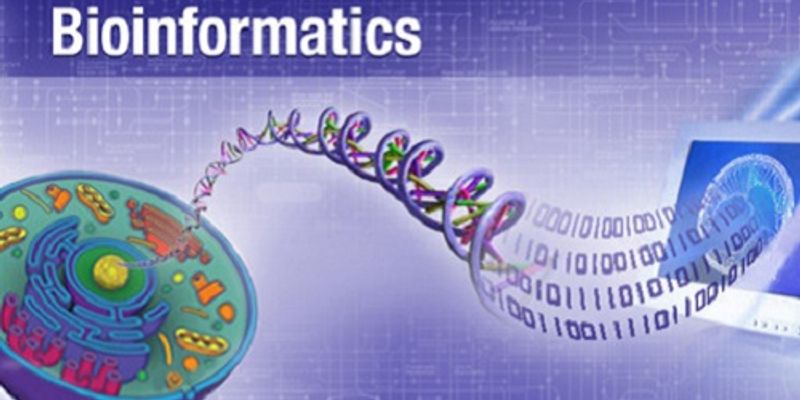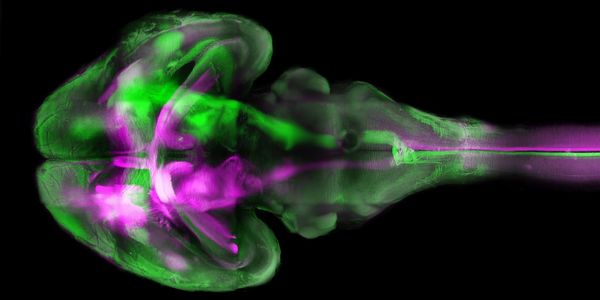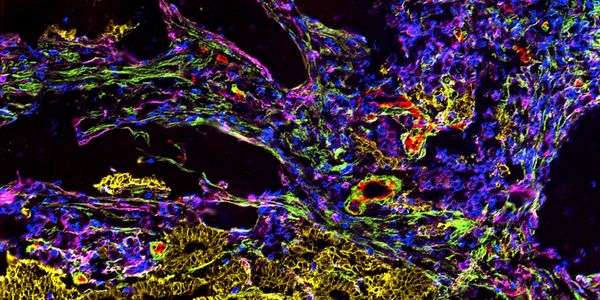Bioinformatics
Bioinformatics: an interdisciplinary field that develops methods and software tools for understanding biological data. As an interdisciplinary field of science, bioinformatics combines computer science, statistics, mathematics, and engineering to analyze and interpret biological data.
-
NOV 19, 2020 | 10:00 AMDate: November 19, 2020 Time: 10:00am (PST), 1:00pm (EST) 98% of in-patients will undergo a diagnostic test during a hospital stay.[1] With the increased focus on the accuracy of diagnostic...NOV 18, 2020 | 8:00 AMDATE: November 18, 2020 TIME: 08:00am PDT We develop and implement technologies to solve some of the major bottlenecks in biomedical research. In particular, we establish new imaging approac...NOV 12, 2020 | 4:30 PMWith QCI services your clinical lab can enable a seamless fastq to clinical report workflow. We provide services such as cloud based variant calling and automated upload of the data to the Q...Speaker: Ajay AthavaleNOV 12, 2020 | 3:00 PMWhat if your lab could perform exome sequencing with the same sensitivity and efficiency of targeted sequencing? The new integrated QIAseq Human Exome TR Insights solution from QIAGEN delive...Speaker: Brian Dugan, M.S. , Rupert Yip, PhDOCT 22, 2020 | 1:15 PMTo identify genetic variants in archival human samples, researchers need a powerful NGS platform that can accommodate input DNA and RNA that is often low quality and/or low quantity. This ch...Speaker: Craig Mackinnon, MD, PhDPresented at: OncomineWorld 2022: A Virtual NGS Education Meeting
SEP 30, 2020 | 1:30 PMRNA plays important and diverse roles in biology, but molecular tools to manipulate and measure RNA are limited. We demonstrate that RNA-targeting CRISPR effector Cas13 can be engineered for...Speaker: Omar Abudayyeh, PhD , Jonathan Gootenberg, PhDPresented at: CRISPR Virtual Event Series 2020
SEP 30, 2020 | 12:00 PMThe CRISPR/Cas genome editing system has revolutionized nearly every aspect of the life science industry. Until recently, the most used formats for this technology have been plasmids, mRNA,...Speaker: Gurpreet Balrey, PhD , Peter Romanienko, PhDSEP 30, 2020 | 10:30 AMCRISPR-based genome editing has accelerated biological research and holds great potential for studying and treating human diseases. The CRISPR-Cas9 system requires a Cas9 nuclease and a guid...Speaker: James Goldmeyer, PhDSEP 30, 2020 | 9:00 AMWhile transformative, first-generation CRISPR technologies remain limited across multiple important dimensions including scalability, editing efficiency, types of modifications available, an...Speaker: Nandini Krishnamurthy, PhDSEP 30, 2020 | 7:30 AMGenome Engineering allows the easy manipulation of genomes down to the nucleotide level. Targeted deep sequencing enables the detection and quantification of low-frequency editing events. Ho...SEP 30, 2020 | 6:00 AMGenome editing with an expanded CRISPR-Cas tool set increases the opportunity to make intentional, targeted changes in the genome. Furthermore, improved specificity of genome editing and abi...SEP 30, 2020 | 12:00 AMCas9 based therapeutics have the potential to revolutionize the treatment of genetic diseases. However, safe and effective methods for delivering Cas9 protein, gRNA and donor DNA need to be...SEP 30, 2020 | 12:00 AMThe adenosine analogue remdesivir has emerged as a front-line antiviral treatment for SARS-CoV-2, with preliminary evidence that it reduces the duration and severity of illness. Prior clinic...SEP 30, 2020 | 12:00 AMCombinatorial inhibition of effector and feedback pathways is a promising treatment strategy for KRAS mutant cancers. However, the particular pathways that should be targeted to optimize the...SEP 30, 2020 | 12:00 AMLearning Objectives: 1. Using an optics- and label-free approach to CRISPR research 2. Explain current approaches to selecting the most robust gRNA for CRISPR assays 3. The opportunities tha...SEP 30, 2020 | 12:00 AMA repeat expansion in the C9orf72-SMCR8 complex subunit (C9orf72) represents the most common genetic cause of two fatal neurodegenerative diseases: frontotemporal dementia (FTD) and amyotrop...SEP 30, 2020 | 12:00 AMAn extensively debated concern about CRISPR-Cas9 genome editing is that unspecific guide RNA (gRNA) binding may induce off-target mutations. However, accurate prediction of CRISPR-Cas9 off-t...SEP 15, 2020 | 8:00 AMDATE: September 15, 2020 TIME: 08:00am PT Tumorigenesis and cancer progression are affected by the tumor immune microenvironment (TIME). The TIME not only influences the efficiency of existi...SEP 10, 2020 | 12:00 PMIn this webinar, we will present QIAGEN CLC Genomics Workbench and its utility for bacterial isolate identification, strain discrimination using core genome multi-locus typing (cgMLST) and d...Speaker: Jonathan Jacobs, PhDSEP 10, 2020 | 12:00 AMThe transfer of antimicrobial resistance genes (ARG) to pathogenic microbes is a major concern in modern medicine. Antibiotic therapies are often rendered ineffective by horizontal acquisiti...SEP 10, 2020 | 12:00 AMLessons around leveraging high-complexity next-generation sequencing tests for precision infectious disease discovery to guide patient treatment and improve health outcomes. Learning Objecti...SEP 09, 2020 | 9:00 AMEpidemics are occurring at an increasing pace and scale. Our laboratory group has developed platform technologies for discovery of broad and potent neutralizing antibodies for many emerging...SEP 09, 2020 | 12:00 AMHuman chromosome 19q13.4 contains genes encoding killer-cell immunoglobulin-like receptors (KIR). The region has certain properties such as single nucleotide variation, structural variation,...SEP 08, 2020 | 11:00 PMBackground: Haemophilus influenzae is the causative agent of multiple human disease conditions among multiple sites in the human body. Underlying genetic mechanisms are elusive, particularly...
NOV 19, 2020 | 10:00 AM
Date: November 19, 2020 Time: 10:00am (PST), 1:00pm (EST) 98% of in-patients will undergo a diagnostic test during a hospital stay.[1] With the increased focus on the accuracy of diagnostic...
NOV 18, 2020 | 8:00 AM
DATE: November 18, 2020 TIME: 08:00am PDT We develop and implement technologies to solve some of the major bottlenecks in biomedical research. In particular, we establish new imaging approac...
NOV 12, 2020 | 4:30 PM
With QCI services your clinical lab can enable a seamless fastq to clinical report workflow. We provide services such as cloud based variant calling and automated upload of the data to the Q...
Speaker:
Ajay Athavale
NOV 12, 2020 | 3:00 PM
What if your lab could perform exome sequencing with the same sensitivity and efficiency of targeted sequencing? The new integrated QIAseq Human Exome TR Insights solution from QIAGEN delive...
Speaker:
Brian Dugan, M.S.
, Rupert Yip, PhD
OCT 22, 2020 | 1:15 PM
To identify genetic variants in archival human samples, researchers need a powerful NGS platform that can accommodate input DNA and RNA that is often low quality and/or low quantity. This ch...
Speaker:
Craig Mackinnon, MD, PhD
Presented at: OncomineWorld 2022: A Virtual NGS Education Meeting
SEP 30, 2020 | 1:30 PM
RNA plays important and diverse roles in biology, but molecular tools to manipulate and measure RNA are limited. We demonstrate that RNA-targeting CRISPR effector Cas13 can be engineered for...
Speaker:
Omar Abudayyeh, PhD
, Jonathan Gootenberg, PhD
Presented at: CRISPR Virtual Event Series 2020
SEP 30, 2020 | 12:00 PM
The CRISPR/Cas genome editing system has revolutionized nearly every aspect of the life science industry. Until recently, the most used formats for this technology have been plasmids, mRNA,...
Speaker:
Gurpreet Balrey, PhD
, Peter Romanienko, PhD
SEP 30, 2020 | 10:30 AM
CRISPR-based genome editing has accelerated biological research and holds great potential for studying and treating human diseases. The CRISPR-Cas9 system requires a Cas9 nuclease and a guid...
Speaker:
James Goldmeyer, PhD
SEP 30, 2020 | 9:00 AM
While transformative, first-generation CRISPR technologies remain limited across multiple important dimensions including scalability, editing efficiency, types of modifications available, an...
Speaker:
Nandini Krishnamurthy, PhD
SEP 30, 2020 | 7:30 AM
Genome Engineering allows the easy manipulation of genomes down to the nucleotide level. Targeted deep sequencing enables the detection and quantification of low-frequency editing events. Ho...
SEP 30, 2020 | 6:00 AM
Genome editing with an expanded CRISPR-Cas tool set increases the opportunity to make intentional, targeted changes in the genome. Furthermore, improved specificity of genome editing and abi...
SEP 30, 2020 | 12:00 AM
Cas9 based therapeutics have the potential to revolutionize the treatment of genetic diseases. However, safe and effective methods for delivering Cas9 protein, gRNA and donor DNA need to be...
SEP 30, 2020 | 12:00 AM
The adenosine analogue remdesivir has emerged as a front-line antiviral treatment for SARS-CoV-2, with preliminary evidence that it reduces the duration and severity of illness. Prior clinic...
SEP 30, 2020 | 12:00 AM
Combinatorial inhibition of effector and feedback pathways is a promising treatment strategy for KRAS mutant cancers. However, the particular pathways that should be targeted to optimize the...
SEP 30, 2020 | 12:00 AM
Learning Objectives: 1. Using an optics- and label-free approach to CRISPR research 2. Explain current approaches to selecting the most robust gRNA for CRISPR assays 3. The opportunities tha...
SEP 30, 2020 | 12:00 AM
A repeat expansion in the C9orf72-SMCR8 complex subunit (C9orf72) represents the most common genetic cause of two fatal neurodegenerative diseases: frontotemporal dementia (FTD) and amyotrop...
SEP 30, 2020 | 12:00 AM
An extensively debated concern about CRISPR-Cas9 genome editing is that unspecific guide RNA (gRNA) binding may induce off-target mutations. However, accurate prediction of CRISPR-Cas9 off-t...
SEP 15, 2020 | 8:00 AM
DATE: September 15, 2020 TIME: 08:00am PT Tumorigenesis and cancer progression are affected by the tumor immune microenvironment (TIME). The TIME not only influences the efficiency of existi...
SEP 10, 2020 | 12:00 PM
In this webinar, we will present QIAGEN CLC Genomics Workbench and its utility for bacterial isolate identification, strain discrimination using core genome multi-locus typing (cgMLST) and d...
Speaker:
Jonathan Jacobs, PhD
SEP 10, 2020 | 12:00 AM
The transfer of antimicrobial resistance genes (ARG) to pathogenic microbes is a major concern in modern medicine. Antibiotic therapies are often rendered ineffective by horizontal acquisiti...
SEP 10, 2020 | 12:00 AM
Lessons around leveraging high-complexity next-generation sequencing tests for precision infectious disease discovery to guide patient treatment and improve health outcomes. Learning Objecti...
SEP 09, 2020 | 9:00 AM
Epidemics are occurring at an increasing pace and scale. Our laboratory group has developed platform technologies for discovery of broad and potent neutralizing antibodies for many emerging...
SEP 09, 2020 | 12:00 AM
Human chromosome 19q13.4 contains genes encoding killer-cell immunoglobulin-like receptors (KIR). The region has certain properties such as single nucleotide variation, structural variation,...
SEP 08, 2020 | 11:00 PM
Background: Haemophilus influenzae is the causative agent of multiple human disease conditions among multiple sites in the human body. Underlying genetic mechanisms are elusive, particularly...
























